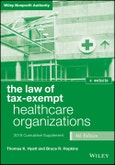The Law of Tax–Exempt Healthcare Organizations 2018 Supplement provides complete and comprehensive practitioner updates and analysis in a single volume. Tackling complex legal issues with plain–English explanations and the appropriate citations, this guide is a must–have resource for organizations and their advisors. The companion website provides extensive appendices for further reference, as well as helpful downloadable tables that facilitate a more efficient approach to practice.
Healthcare law is a complex field, and keeping up with the frequent changes to federal law is itself a full time job. This book eliminates the need for extended research time by collecting all of the newest and relevant guidelines into one place.
- Get up to date on the latest IRS forms, guidance, and procedures
- Interpret complex legal issues correctly and appropriately
- Reference relevant federal guidelines quickly and easily
- Access extensive appendices and tables to streamline application
As the field evolves and new issues arise, practitioners need a working knowledge of the legal implications behind organizational activities, structure, practices, and more. This most recent annual supplement to The Law of Tax–Exempt Healthcare Organizations is a must–have resource for anyone in the field.
Table of Contents
Preface ix
About the Authors xi
Book Citations xv
1 Tax–Exempt Healthcare Organizations An Overview 1
∗§ 1.2 Defining Tax–Exempt Organizations 1
§ 1.5 Charitable Healthcare Organizations 1
§ 1.10 ABLE Programs 2
3 Public Charities and Private Foundations (New) 5
§ 3.3 Commerciality Doctrine 5
4 Private Inurement, Private Benefit, and Excess Benefit Transactions 7
§ 4.4 Private Inurement Scope and Types 7
§ 4.6 Essence of Private Benefit 8
§ 4.9 Excess Benefit Transactions 10
5 Public Charities and Private Foundations 11
∗§ 5.1 Public Institutions 11
∗§ 5.6 Recognition of Change in Public Charity Status 11
7 Lobbying and Political Activities 13
§ 7.1 Legislative Activities Limitation 13
∗§ 7.4 Political Activities Limitation 14
§ 7.5 Business Expense Deduction Rules and Political Activities 16
∗§ 7.7 Public Policy Advocacy Activities 16
∗§ 7.8 Political Activities of Social Welfare Organizations 16
9 Managed Care Organizations 19
∗§ 9.3 Commercial–Type Insurance Providers 19
∗§ 9.5 Recent Developments 19
13 Other Provider and Supplier Organizations 23
∗§ 13.3 Qualified Nonprofit Health Insurance Issuers 23
∗§ 13.5 Accountable Care Organizations 24
16 For–Profit Subsidiaries 29
∗§ 16.3 Attribution of Subsidiary s Activities to Exempt Parent 29
17 Exempt and Nonexempt Cooperatives 31
§ 17.1 Cooperative Hospital Service Organizations 31
18 Business Leagues 33
∗§ 18.1 Business Leagues in General 33
∗§ 18.2 Healthcare Trade Associations 34
19 Other Health–Related Organizations 35
§19.4 Hospital Management Services Organizations 35
∗§19.5 Regional Health Information Organizations 36
20 Healthcare Provider Reorganizations 37
§ 20.1 Some Basics about Reorganizations 37
21 Mergers and Conversions 39
§ 21.4 Conversion from Nonexempt to Exempt Status 39
22 Partnerships and Joint Ventures (New) 41
§ 22.9 Whole–Hospital Joint Ventures 41
24 Tax Treatment of Unrelated Business Activities 43
§ 24.2 Definition of Trade or Business 43
∗§ 24.3 Definition of Regularly Carried On 45
∗§ 24.5 Application of Substantially Related Test to Healthcare Organizations 46
∗§ 24.11 Pharmacy, Medical Supplies, and Service Sales 47
§ 24.12 Laboratory Testing Services 47
∗§ 24.13 Medical Research 48
∗§ 24.18 Other Exceptions to Unrelated Income Taxation 49
§ 24.20 Revenue from Controlled Organizations 51
∗§ 24.21 Unrelated Debt–Financed Income 51
§ 24.23 Computation of Unrelated Business Taxable Income 51
25 Physician Recruitment and Retention 53
∗§ 25.5 Specific Recruitment and Retention Techniques 53
26 Charity Care 55
∗§ 26.6 Definitional and Reporting Issues 55
∗§ 26.9 Charity Care and National Health Reform 56
∗§ 26.10 Additional Statutory Requirements for Hospitals 56
27 Worker Classification and Employment Taxes 73
§ 27.7 Medical Residents and the Student Exception 73
28 Compensation and Employee Benefits 75
∗§ 28.3 Executive Compensation 75
§ 28.5 Overview of Employee Benefits Law 75
§ 28.6 Deferred Compensation in General 76
30 Tax–Exempt Bond Financing 81
∗§ 30.3 Disqualification of Tax–Exempt Bonds 81
31 Fundraising Regulation 91
§ 31.2 Federal Law Regulation 91
33 Governance 93
§ 33.4A IRS Ruling Policy 93
34 Exemption and Public Charity Recognition Processes 97
∗§ 34.1 Exemption Recognition Process 97
∗§ 34.5 Public Charity Status 107
∗§ 34.6 Group Exemption 107
§ 34.7A Notice Requirements for Social Welfare Organizations (New) 107
∗§ 34.8 Procedure Where Determination Is Adverse 109
§ 34.9 Constitutional Law Aspects of Process 110
35 Maintenance of Tax–Exempt Status and Avoidance of Penalties 111
∗§ 35.1 Material Changes 111
§ 35.2A Modification of Tax Exemption (New) 113
∗§ 35.4 Redesigned Annual Information Return 113
∗§ 35.5 Disclosure Requirements 114
∗§ 35.6 IRS Disclosure to State Officials 114
36 IRS Audits of Healthcare Organizations 115
∗§ 36.2 Audit Procedures 115
Cumulative Table of Cases 121
Cumulative Table of IRS Revenue Rulings 131
Cumulative Table of IRS Revenue Procedures 135
Cumulative Table of IRS Private Letter Rulings 137
Cumulative Table of IRS Technical Advice Memoranda 143
Table of Chief Counsel Advice Memoranda 145
Cumulative Table of IRS General Counsel Memoranda 147
Table of Tax Reform Legislation 149
Cumulative Index 155








